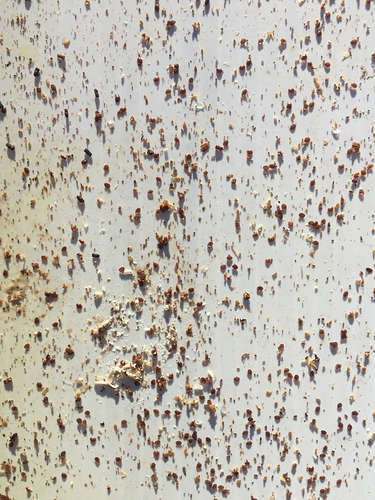I’m not computer savvy so if you go to Facebook. Page you can see pictures of setup.
Interesting new research. We all know that Varroa feed on bee blood (hemolymph), right? Wrong! They are actually feeding on fat bodies. This article has a link to a video recording of the lecture about it:
Meanwhile, here is a photo 24 hours after my latest OAV treatment. Scary stuff!
Fat bodies??? I’d better go check myself for mites!
You can get Dawn to do a sugar roll for ya, then have a vape together 
Be glad you’re treating yours. As a newbie I’ve come across so many experienced bee keepers that procrastinate treating the bees and just buy more in the spring. I find that sad and expensive. If it were a theory or belief or trial it wouldn’t bother me but neglect…that chaps my fanny.
That’s a great photo. Are you treating every 5 days for 15 days? What’s your program? Interestingly enough after going to the link you posted this is what I got sucked into from the same site. https://honeybeesuite.com/its-not-about-mites-any-more/
I treat every 5 or 6 days, usually for three treatments. However after each OAV, I do an “accelerated mite drop” count, checking the mites on the core flute slider. This is a standard British method and is a very good indicator. I document the drop by photographing the board. If the count on the whole board is higher than 25 mites, I treat again 5 days after the last treatment, and keep treating until it drops below 25. My record is 6 treatments. If I had to do more than that, I might consider Apivar once a year.
I saw this gal outside the hive - looked like it was trying to groom or something. Could this bee DWV? Haven’t seen any others…
Certainly could be, although it doesn’t look severe. I would think about doing mite counts ASAP and treating if needed! 
I did a drop count and there were 3 mites in 24h. Think that’s adequate?
I don’t have a sugar shaker or alcohol washer - maybe I’ll do a longer drop count (but it’s really hot this week and I kind of want the screen open for ventilation). And then next time the hive is open (I was thinking in 10 days) I’ll look more carefully at their wings and do a sugar shake.
Sound reasonable?
I do not. Unless the drop was an “accelerated drop count” following oxalic acid vapor treatment. Otherwise, you really need a sugar roll or alcohol wash. I am not trying to make more work for you, but if you want your bees to be safe, you have to go the extra step. ![]()
I’ll do a sweet treatment when I open the hive next time.
I read on some post about rhubarb for maintenance OA treatment - anybody try this? Any concern about sublethal dosing and accelerating development of resistance?
I do have a vaporizer and OA powder so I’m ready to treat if the need arises and I planned to treat in the late summer/early fall…
Not sure what that is… ![]()
Raw rhubarb (and leaves) is unproven as a varroa treatment. There are many anecdotal claims, but no scientific studies. On the other hand, lots of long term studies of purified OA administered via recognized measurable dosing show no evidence of resistance developing, even after many years. It remains one of the more effective treatments, along with formic acid, and several non-organic (man made) miticides.
I have lost enough bees to varroa now. I stick with the science and treat my bees with proven methods. ![]()
[quote=“chau06, post:95, topic:10596, full:true”].
I read on some post about rhubarb for maintenance OA treatment - anybody try this? Any concern about sublethal dosing and accelerating development of resistance?
[/quote]
The concern about sub lethal dosing is that it won’t work. There are no concerns about bees developing resistance to OA.
Varroa is not like a normal parasite that needs its host to survive. Varroa mites feed off the bees liver (the fat body) and seriously damage the bee for life, making the colony susceptible to a host of viral diseases.
So don’t faff around with rhurbarb leaves or suchlike.
OA vapour is organic and can be used at any time of the year, just remove the supers when you treat (and use protection yourself). So I wouldn’t wait. Drones are also being produced now and this massively increases the varroa load in the hive.
For interest when did you last treat and what was the post treatment drop like then?
I am not opposed to OA or FA or even non-organic treatments if the need was dire - but I do have a lot of rhubarb plants and if there were data to support putting a couple leaves in the hive for some sort of suppressive treatment when the levels are low, then it would be easy for me to do.

